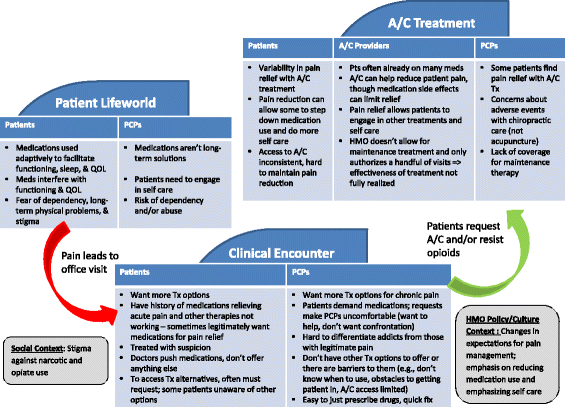Provider and patient perspectives on opioids and alternative treatments for managing chronic pain: a qualitative study
- PMID: 28403822
- PMCID: PMC5390355
- DOI: 10.1186/s12875-016-0566-0
Provider and patient perspectives on opioids and alternative treatments for managing chronic pain: a qualitative study
Abstract
Background: Current literature describes the limits and pitfalls of using opioid pharmacotherapy for chronic pain and the importance of identifying alternatives. The objective of this study was to identify the practical issues patients and providers face when accessing alternatives to opioids, and how multiple parties view these issues.
Methods: Qualitative data were gathered to evaluate the outcomes of acupuncture and chiropractic (A/C) services for chronic musculoskeletal pain (CMP) using structured interview guides among patients with CMP (n = 90) and primary care providers (PCPs) (n = 25) purposively sampled from a managed care health care system as well as from contracted community A/C providers (n = 14). Focus groups and interviews were conducted patients with CMP with varying histories of A/C use. Plan PCPs and contracted A/C providers took part in individual interviews. All participants were asked about their experiences managing chronic pain and experience with and/or attitudes about A/C treatment. Audio recordings were transcribed and thematically coded. A summarized version of the focus group/interview guides is included in the Additional file 1.
Results: We identified four themes around opioid use: (1) attitudes toward use of opioids to manage chronic pain; (2) the limited alternative options for chronic pain management; (3) the potential of A/C care as a tool to help manage pain; and (4) the complex system around chronic pain management. Despite widespread dissatisfaction with opioid medications for pain management, many practical barriers challenged access to other options. Most of the participants' perceived A/C care as helpful for short term pain relief. We identified that problems with timing, expectations, and plan coverage limited A/C care potential for pain relief treatment.
Conclusions: These results suggest that education about realistic expectations for chronic pain management and therapy options, as well as making A/C care more easily accessible, might lead to more satisfaction for patients and providers, and provide important input to policy makers.
Trial registration: ClinicalTrials.gov NCT01345409 , date of registration 28/4/2011.
Keywords: Acupuncture; Chiropractic; Chronic pain; Complementary medicine; Opioids; Primary care.
Figures
Similar articles
-
Acupuncture and chiropractic care for chronic pain in an integrated health plan: a mixed methods study.BMC Complement Altern Med. 2011 Nov 25;11:118. doi: 10.1186/1472-6882-11-118. BMC Complement Altern Med. 2011. PMID: 22118061 Free PMC article. Clinical Trial.
-
Primary care physicians, acupuncture and chiropractic clinicians, and chronic pain patients: a qualitative analysis of communication and care coordination patterns.BMC Complement Altern Med. 2016 Jan 25;16:30. doi: 10.1186/s12906-016-1005-4. BMC Complement Altern Med. 2016. PMID: 26810302 Free PMC article.
-
Acupuncture and chiropractic care: utilization and electronic medical record capture.Am J Manag Care. 2015 Jul 1;21(7):e414-21. Am J Manag Care. 2015. PMID: 26295269 Free PMC article.
-
A Comprehensive Review of Alternative Therapies for the Management of Chronic Pain Patients: Acupuncture, Tai Chi, Osteopathic Manipulative Medicine, and Chiropractic Care.Adv Ther. 2021 Jan;38(1):76-89. doi: 10.1007/s12325-020-01554-0. Epub 2020 Nov 12. Adv Ther. 2021. PMID: 33184777 Free PMC article. Review.
-
Chiropractic services in the active duty military setting: a scoping review.Chiropr Man Therap. 2019 Jul 15;27:45. doi: 10.1186/s12998-019-0259-6. eCollection 2019. Chiropr Man Therap. 2019. PMID: 31338157 Free PMC article.
Cited by
-
Attitudes Toward a Pre-authorized Concealed Opioid Taper: A Qualitative Analysis of Patient and Clinician Perspectives.Front Psychiatry. 2022 Mar 24;13:820357. doi: 10.3389/fpsyt.2022.820357. eCollection 2022. Front Psychiatry. 2022. PMID: 35401245 Free PMC article.
-
Effects of Pulsatile Cupping on Body Pain and Quality of Life in People with Suboptimal Health:A Randomized Controlled Exploratory Trial.Med Acupunct. 2018 Dec 1;30(6):326-335. doi: 10.1089/acu.2018.1313. Med Acupunct. 2018. PMID: 30671153 Free PMC article.
-
Predictors of visit frequency for patients using ongoing chiropractic care for chronic low back and chronic neck pain; analysis of observational data.BMC Musculoskelet Disord. 2020 May 13;21(1):298. doi: 10.1186/s12891-020-03330-1. BMC Musculoskelet Disord. 2020. PMID: 32404152 Free PMC article.
-
Experiences of people taking opioid medication for chronic non-malignant pain: a qualitative evidence synthesis using meta-ethnography.BMJ Open. 2020 Feb 18;10(2):e032988. doi: 10.1136/bmjopen-2019-032988. BMJ Open. 2020. PMID: 32075828 Free PMC article.
-
Provider Perspectives of Battlefield Acupuncture: Advantages, Disadvantages and Its Potential Role in Reducing Opioid Use for Pain.Med Care. 2020 Sep;58 Suppl 2 9S(2 9 Suppl):S88-S93. doi: 10.1097/MLR.0000000000001332. Med Care. 2020. PMID: 32826777 Free PMC article.
References
-
- Institute of Medicine. Relieving Pain in America: A Blueprint for Transforming Prevention, Care, Education, and Research. Washington, DC: National Academies Press; 2010. - PubMed
-
- Kuehn BM. Opioid prescriptions soar. JAMA. 2007;297:249. - PubMed
-
- Manchikanti L, Helm S, Fellows B, Janata JW, Pampati V, Grider JS, Boswell MV. Opioid epidemic in the Uited States. Pain Physician. 2012;15:ES9–38. - PubMed
Publication types
MeSH terms
Substances
Associated data
Grants and funding
LinkOut - more resources
Full Text Sources
Other Literature Sources
Medical


